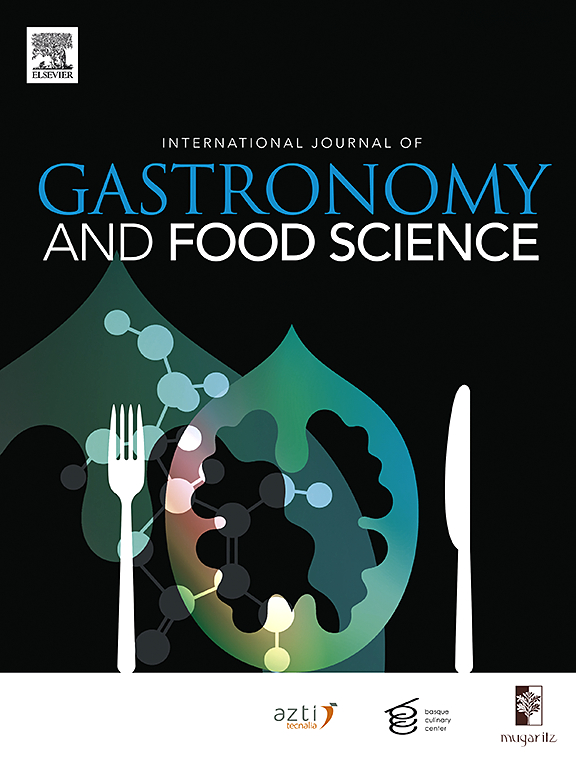Emulsion characteristics and interfacial adsorption behavior of chicken white soup with added sarcoplasmic protein during stewing
IF 3.6
2区 农林科学
Q2 FOOD SCIENCE & TECHNOLOGY
International Journal of Gastronomy and Food Science
Pub Date : 2025-09-16
DOI:10.1016/j.ijgfs.2025.101300
引用次数: 0
Abstract
This study investigated the effects of sarcoplasmic protein (SP) addition at different concentrations (0 %, 0.14 %, 0.28 %, 0.42 %, 0.56 %, 0.70 %, and 0.84 %) on the characteristics and interfacial adsorption behavior of chicken white soup emulsions prepared from stewed chicken skeletons. The results indicated that the soup with 0.56 % SP addition exhibited the smallest droplet size, reflected by the lowest D3,2 (1.962 μm) and D4,3 value (3.666 μm), along with the highest absolute value of zeta potential (23.19 mV) and viscosity. Interfacial dilatational rheology kinetic modeling further revealed a significantly higher diffusion rate (Kdiff) for the soup with 0.56 % SP addition compared to other groups. Scanning electron microscopy (SEM) observations confirmed the formation of an emulsion system with smaller droplet size and a more uniform size distribution in the soup with 0.56 % SP addition. Additionally, low-field nuclear magnetic resonance (LF-NMR) imaging demonstrated stability for this soup formulation. This study established a theoretical foundation for the preparation of chicken white soup with enhanced stability.

加入肌浆蛋白后鸡汤的乳化特性及界面吸附行为
研究了不同浓度(0%、0.14%、0.28%、0.42%、0.56%、0.70%、0.84%)的肌浆蛋白(SP)添加量对以炖鸡骨架为原料制备的鸡白汤乳剂的特性和界面吸附行为的影响。结果表明,当SP添加量为0.56%时,液滴尺寸最小,D3,2值(1.962 μm)和D4,3值(3.666 μm)最低,zeta电位绝对值(23.19 mV)和粘度最大;界面膨胀流变动力学模型进一步显示,添加0.56% SP的汤的扩散速率(Kdiff)显著高于其他组。扫描电镜(SEM)观察证实,当SP添加量为0.56%时,形成了粒径更小、粒径分布更均匀的乳液体系。此外,低场核磁共振(LF-NMR)成像证明了该汤配方的稳定性。本研究为制备稳定度更高的鸡汤奠定了理论基础。
本文章由计算机程序翻译,如有差异,请以英文原文为准。
求助全文
约1分钟内获得全文
求助全文
来源期刊

International Journal of Gastronomy and Food Science
Social Sciences-Cultural Studies
CiteScore
5.30
自引率
10.50%
发文量
170
审稿时长
45 days
期刊介绍:
International Journal of Gastronomy and Food Science is a peer-reviewed journal that explicitly focuses on the interface of food science and gastronomy. Articles focusing only on food science will not be considered. This journal equally encourages both scientists and chefs to publish original scientific papers, review articles and original culinary works. We seek articles with clear evidence of this interaction. From a scientific perspective, this publication aims to become the home for research from the whole community of food science and gastronomy.
IJGFS explores all aspects related to the growing field of the interaction of gastronomy and food science, in areas such as food chemistry, food technology and culinary techniques, food microbiology, genetics, sensory science, neuroscience, psychology, culinary concepts, culinary trends, and gastronomic experience (all the elements that contribute to the appreciation and enjoyment of the meal. Also relevant is research on science-based educational programs in gastronomy, anthropology, gastronomic history and food sociology. All these areas of knowledge are crucial to gastronomy, as they contribute to a better understanding of this broad term and its practical implications for science and society.
 求助内容:
求助内容: 应助结果提醒方式:
应助结果提醒方式:


